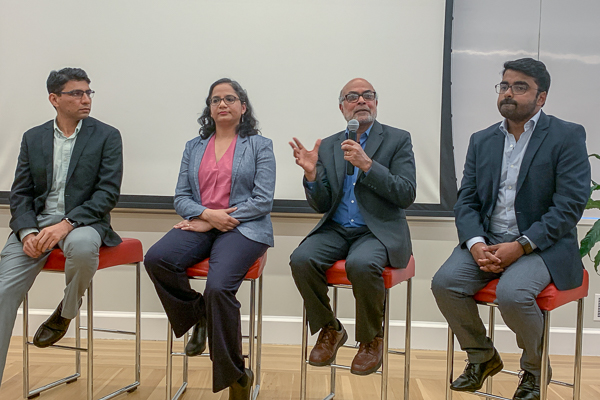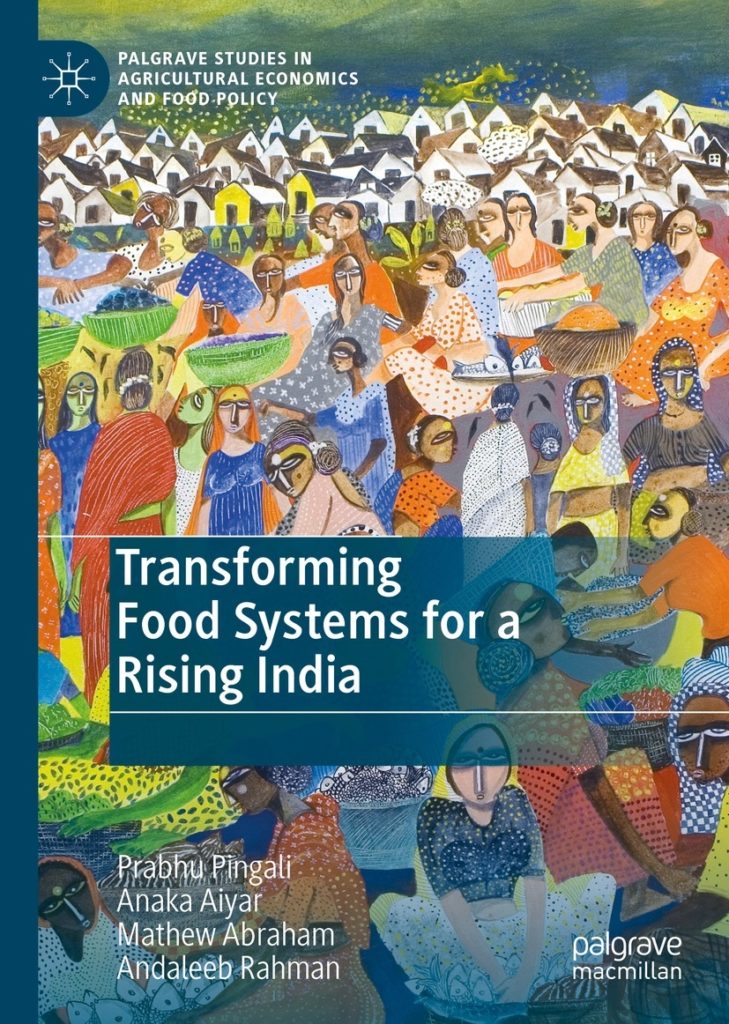Tata-Cornell Institute’s co-authors launch new book on food systems in India

Co-authors from the Tata-Cornell Institute for Agriculture and Nutrition and the Dyson School have published a new book, Transforming Food Systems for a Rising India, as a reflection of the institute’s key intellectual results and research works undertaken within the past five years.
 At a glance:
At a glance:
Book title
Transforming Food Systems for a Rising India
Published by Palgrave Macmillan, 2019
Co-authors
- Prabhu Pingali, professor of applied economics at Dyson and founding director of the Tata-Cornell Institute
- Anaka Aiyar, post-doctoral associate with the Tata-Cornell Institute
- Mathew Abraham, assistant director of the Tata-Cornell Institute
- Andaleeb Rahman, post-doctoral associate at the Tata-Cornell Institute
Disciplines represented
Agricultural Economics, Food Policy, Health and Nutrition, Sustainability
About the book
Transforming Food Systems for a Rising India explores the relationship between India’s economic development, agricultural production, and nutrition through the lens of a “food systems approach.” The authors investigate the paradoxical story of India’s growth where regional inequality, food insecurity, and malnutrition still exist within economic progress.
By collecting the latest data and scientific evidence from the country, the authors examine the challenges and opportunities for achieving a nutrition-secure future. The book offers potential solutions along with political and institutional interventions needed to alter the future of India’s food system.
“This book… brings together high quality research, real world pragmatism and an understanding of the politics of Indian food systems.” — Lawrence Haddad, Executive Director, GAIN and 2018 World Food Prize Laureate
“Using a broad food systems approach, this book presents [a]… comprehensive analysis of the Indian food and agricultural system and its interaction with climate change, nutrition and health.” — Per Pinstrup-Andersen, Professor Emeritus, Cornell University and 2001 World Food Prize Laureate
Insights from the authors
The Tata-Cornell Institute celebrated the launch of the book in May 2019 with a panel discussion featuring the authors and an introduction from Christopher Barrett, the Stephen B. and Janice G. Ashley Professor at Dyson. During the event, the co-authors shared key takeaways from their respective chapters.

Prabhu Pingali, professor of applied economics at Dyson and founding director of the Tata-Cornell Institute
- India has solved its hunger problem to some extent, but problems like under- and malnutrition still exist. Despite India’s characterization as an emerging economy, significant segments of the rural population still live in poverty and suffer from illness and malnutrition.
- There is a big opportunity to invigorate India’s rural economy through diversifying the food system. For nutritional security, poor people should have better and affordable access to micro-nutrient rich foods.
- Food system diversity can help manage India’s nutrition challenges. The staple grain-focused policies and weak market infrastructure for non-staple foods hinder the diversification of India’s food system.
- Mitigating climate impacts on nutrition-rich food crops is significant for poor people. Inter-state and inter-country learnings about India’s rural growth are worth sharing.

Anaka Aiyar, post-doctoral associate with the Tata-Cornell Institute
- Despite India’s decrease in malnutrition across the country in the past 30 years, undernutrition and micronutrient deficiency persists, especially in economically lagging states like Bihar, Uttar Pradesh, and Madhya Pradesh. Still, 38 percent of all children in India under the age of five are stunted.
- On the other hand, issues like overweight and obesity have appeared as big challenges, especially in more urbanized states. Overall, the population of overweight people has doubled during the past 10 years.
- India needs to refocus its public policy to transform the food system and address the triple burden of malnutrition. Diversifying diets, increasing income, and improving people’s access to food safety nets are vital for reducing malnutrition.

Mathew Abraham, assistant director of the Tata-Cornell Institute
- Shifts towards high-value agriculture products can provide opportunities for diversifying and accessing markets. But these opportunities have not translated into benefits for small agricultural producers. Effective aggregation models, such as producer group, can help reduce high transaction costs of small farms accessing urban food value chains. The major issues are limited access to markets, credit, inputs, and production technologies.
- There is a need for adaptation and mitigation strategies to cope with the impacts of climate change in agriculture. Future climate change policies should enable the diversification of environment-friendly food systems as well as improve the nutritional value of foods produced and increase affordable access to food. Region-specific approaches are needed to address the issues.
- Technology will play an important role in increasing smallholder productivity and competitiveness. States, especially lagging ones, need to go beyond staple grains and use appropriate technologies for promoting a more diverse food system.

Andaleeb Rahman, post-doctoral associate at the Tata-Cornell Institute
- The one-size-fits-all approach does not work for India when developing and implementing policies, given the state-level differences in economic growth, agricultural production, cultures, and environments, among other factors.
- Initial investments in agricultural productivity kicked off different trajectories in economic growth. For instance, agriculture-led growth states like Punjab and Haryana invested heavily in paddy cultivation while urbanizing states, like Kerala and Tamil Nadu, prefer cash crops and non-ag sectors like industry and tourism. However, several states in east India are primarily smallholder agriculture systems.
- India has witnessed a low rate of migration in recent years. As villages are coming closer to small towns, people are commuting to work rather than migrating to urban areas. This allows new growth opportunities for rural Indians.
- Safety nets have been an essential component of poverty reduction policies in India, providing income and nutrition assistance across different stages of life. However, the objectives and design of India’s safety net programs, whether food or cash based, need to evolve with economic growth and the changing nutritional needs of marginalized populations.
About the Tata-Cornell Institute
The Tata-Cornell Institute (TCI) was founded with the generous support of Ratan Tata ’62 (AAP), former chairman of the Tata Group of India. Through the Tata Education and Development Trust, Tata provided $25 million to Cornell University to support a long-term research initiative. TCI conducts research, provides thought leadership, and engages stakeholders working in agriculture, nutrition, and food policy. TC I is part of the College of Agriculture and Life Sciences and hosted by the Charles H. Dyson School of Applied Economics and Management.
Learn more about the Tata-Cornell Institute and how to read their new book here.
